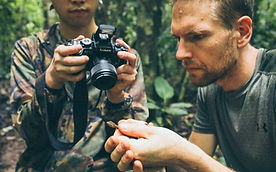top of page

Volunteer and Internship Program
Venture deep into the Amazon rainforest to study wildlife, collect vital data, and develop your conservation research skills through immersive, hands-on experiences.
Since 1997, Fauna Forever has been welcoming Peruvian and international volunteers, interns, and thesis students to the Peruvian Amazon. Our internship programs are aimed at those who want to assist our day-to-day biodiversity research activities, learn new field skills and techniques, and develop knowledge of the neotropics. Our team of experienced research coordinators will provide support and training tailored to each individual's level of experience. The longer you spend with us, the more opportunity you have to progress your skills. Interns will be provided with certificates confirming their participation and completion of the program.
We welcome specialists and those with a particular area of interest, however, our interns are encouraged to explore opportunities to work across our teams. You might just discover a new found passion for another field of study. You might be fanatical for herps, but why not head out before sunrise with our bird team to learn about the research techniques used here...(don't worry, plenty of coffee is provided!) In the past we've had diehard birders visit us who end up leaving with a new found enthusiasm for bat research.
At Fauna Forever, we pride ourselves on offering experiences filled with opportunities to learn new skills. If you come with an open mind and strong work-ethic, you'll get the most out of your time with us!
Costs
Opportunities are available for short or extended periods of time throughout the year and for candidates with a variety of research skill levels and time considerations. The majority of applicants are required to pay a fee to help cover the cost of their stay with us, as our central funding is limited. These fees cover all costs associated with transport to research sites on select camp transfer days*, food, lodging, and certain items of equipment that volunteers and interns use frequently. The donation/fee does not include: Bank charges incurred when making funds, transfers; flights to/from project city, cost for hostels, hotels and food in project city (e.g. Puerto Maldonado - PEM); travel or health insurance for the duration of your stay with us (which is compulsory for all Fauna Forever participants); un-scheduled transport; or any personal medical expenses, laundry, bottled beverages, and snacks. A very limited number of funded internships are available to Peruvian applicants via our partner Wilderness International's scholarship program.

The costs shown above are estimates based on internship programmes at our Secret Forest research site. Costs may differ for other research sites. It is possible to stay longer than 8 weeks. Please indicate this in your preferred dates in the internship application form. Our team will then be able to provide further details regarding costs.
*If you wish to travel to or from the research site on a specific date and time of your choosing, outside of the planned camp transfer days, an additional charge will apply.
Mammal Team
Learn the techniques used to study diversity, abundance, and distribution of over 110 species of rainforest mammals
Bird Team
Assist us using mist nets and point counts to understand population size, activity patterns, and age characteristics of over 600 species
Herpetofauna Team
Assist with reptile and amphibian population sampling protocols focused on a total of over 200 species of herpetofauna
Bat Team
Study the diversity, population dynamics, and habitat requirements of over 115 species of bat
Help our team understand tree diversity and population dynamics, especially of large, long-lived, and key-stone species
Botany & Tree Team
Nature Photography Team
Bring camera gear and work alongside professionals helping to collect imagery for scientific purposes and telling conservation stories
Forest Guardian Team
Join us at the sharp end of protected area conservation and find out what it takes to counter threats to biodiversity. Spanish required
Primate Team
Assist in the study of home range, behaviour, and diet of 11 species of primates
Invertebrate Team
Learn to sample and identify Neotropical butterflies, beetles, and spiders, and marvel the sheer diversity of these groups
bottom of page


.jpg)


_JPG.jpg)
%20smal.jpg)


.jpg)